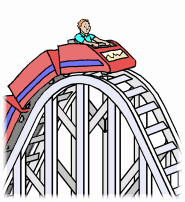 My Letter # 34 about stop loss orders created some heated discussions amongst my readers.
I must confess that for a long time I used no stop loss orders but I now wonder how
I survived this roller-coaster sharemarket without such free insurance. " Don't start anything unless you
know how to finish it", holds true for almost anything in life, and no more so
than in share trading.
My Letter # 34 about stop loss orders created some heated discussions amongst my readers.
I must confess that for a long time I used no stop loss orders but I now wonder how
I survived this roller-coaster sharemarket without such free insurance. " Don't start anything unless you
know how to finish it", holds true for almost anything in life, and no more so
than in share trading.
I now set an initial stop loss order the moment I buy a share. If the share price has moved slightly above my buying price, I replace it with a break-even stop and, eventually, with paper profits accumulating, I set a trailing stop which I progressively update as the share price moves higher.
In determining my stop loss, I set it just below a round figure, as prices often rebound from round figures due to "rounditis". This is an affliction that takes a hold on even experienced traders. Traders are generally drawn to buy and sell at round dollar values. Levels of support and resistance are often visible at psychologically significant values and it is uncanny to see how many times a reversal in share price accurs at $2.00, $2.20 or $2.50, for example.
I use the 1 percent rule: when buying a share, I first determine my stop loss exit point, then work out the number of shares this allows me to buy to ensure I don't risk more than 1 per cent of my total capital. Overriding this is my 20 per cent rule: I don't allow any one share to exceed 20 per cent of my total portfolio. You may be comfortable with a riskier approach and increase your percentages to, say, 2 percent and 25 percent. Here is my step-by-step approach:
|
Step 1 Determine how much money in total I have invested in the market. (note that when building a portpolio, I never place more than 20 per cent maximum of this in a single position) Step 2 How much money am I prepared to lose in each position? (because of the size of my portfolio, I have made this 1 per cent.) Step 3 At the time I buy a share, I also determine a logical stop loss point (the best types of stop losses are those that take into account the "personality" of the share. By setting an arbitrary stop based on a whim, rather than the past behaviour of the share, it is likely that I will be stopped out of a trade without a logical reason) Step 4
|
 This is all quite easy to do but if it still seems too complicated for you,
you may be interested in the much simpler method depicted on the right. This
method is known as "the ultimate stop loss order".
This is all quite easy to do but if it still seems too complicated for you,
you may be interested in the much simpler method depicted on the right. This
method is known as "the ultimate stop loss order".
|
then for goodness' sake, stop trading IMMEDIATELY! |
Best wishes and
from us all!
Peter & Padma & Malty & Rover
& Rover
riverbend@batemansbay.com
11 May 2006